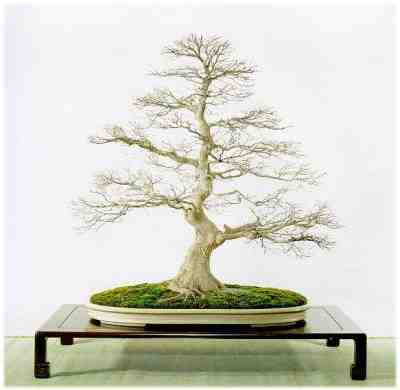|
Bonsai ("The tree in the pot")
 The Bonsai
class is held once a month. The student starts
from the very beginning, working on his or her
own plant (which can be a shrub, nursery
material or others) by potting, root pruning,
branch pruning, wiring and other specific
techniques. It is an ongoing patient process
to assist the development of your bonsai. The
magnitude of the wild nature slowly is
reproduced at a miniaturized scale in the
student's pot. The bonsai combines the
gardener's knowledge (plant growing,
fertilizing, care and disease control,
training, potting, etc), with the artistic
skills and compositional criteria applied to
the tree development. The tree has to develop
three dimensionally, expressing the space, the
power of nature and the struggle for life. It
must keep intact the "spirit of the tree,"
which gives the essence of bonsai. Without
this, the remaining is only a plant in the
pot. On the other hand, the trees' shapes
suggest the tranquil movement of the smoke in
an incense pot, a deep invitation to
meditation. The pot becomes a main part of the
bonsai establishing an interactive relation
with the tree. The Bonsai
class is held once a month. The student starts
from the very beginning, working on his or her
own plant (which can be a shrub, nursery
material or others) by potting, root pruning,
branch pruning, wiring and other specific
techniques. It is an ongoing patient process
to assist the development of your bonsai. The
magnitude of the wild nature slowly is
reproduced at a miniaturized scale in the
student's pot. The bonsai combines the
gardener's knowledge (plant growing,
fertilizing, care and disease control,
training, potting, etc), with the artistic
skills and compositional criteria applied to
the tree development. The tree has to develop
three dimensionally, expressing the space, the
power of nature and the struggle for life. It
must keep intact the "spirit of the tree,"
which gives the essence of bonsai. Without
this, the remaining is only a plant in the
pot. On the other hand, the trees' shapes
suggest the tranquil movement of the smoke in
an incense pot, a deep invitation to
meditation. The pot becomes a main part of the
bonsai establishing an interactive relation
with the tree.
It is a unique experience of Mind,
Body and
Spirit fusion to transform a shrub
into a powerful symbol of life, harmony,
tranquility and balance.
The Chinda
Institute offers to the existing students
workshops for Bonsai as well as for learning
to produce the pots necessary for their
Bonsai. When the class is announced, the
necessary materials (plants, soils, etc)
will be listed. Students have an option to
get those materials on their own or the
Institute will provide them, reflected in a
small fee which includes also the charge for
the equipment usage. The tools are the
student's responsibility.
For more information about Bonsai,
link to Pittsburgh
Bonsai Society.
History of Bonsai
Noone knows exactly when the first bonsai
was grown, but it is known that the ancient
Chinese were experts in creating landscapes in
shallow containers, complete with trees,
rocks, moss and others, known as PENJING. The
first recordings about Penjing appear in
Chinese temple mural paintings, during the Han
dynasty, around 200 BC.
The single tree planted in a pot came later,
called "PUN-SAI." This is the Chinese root of
the Japanese word "BONSAI", both translated as
"Tree in a pot."

When the Chinese invaded Japan in the Middle
Ages, they introduced the Buddhist religion,
and, together with this, the Bonsai. For
centuries the ownership of bonsai was
restricted to those of noble birth or high
office. All bonsai were created from old
stunted trees collected from the mountains,
where the harsh environment had restricted
their size and given them gnarled and twisted
shapes. The tenacity of these trees was held
in such reverence that they were deemed to
posses spiritual qualities which would be
inherited by their owners.
It was not until this century that the
ordinary citizen began to cultivate bonsai, by
which time it had become a highly refined and
structured discipline. (from Growing &
Displaying Bonsai, C. Lewis, N. Shuterland)
|




 The
The 
